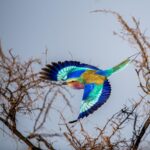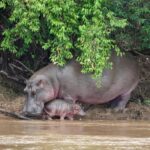
Kenya offers an unparalleled blend of exhilarating wildlife safaris and serene beach holidays, making it a top destination for travelers seeking diverse experiences. This East African nation is renowned for its abundant wildlife, diverse landscapes, and vibrant culture, providing a comprehensive African adventure. Combining a safari with a beach stay allows visitors to experience the thrill of game drives followed by relaxation on pristine coastal shores.
Wildlife safaris with the tranquility of beach holidays
Kenya is home to 23 national parks and game reserves, solidifying its reputation as one of Africa’s premier safari destinations due to its vast animal populations. The country’s landscapes are incredibly varied, ranging from expansive savannahs to towering mountains, creating a stunning backdrop for wildlife viewing. Key safari locations include the Maasai Mara, Amboseli National Park, Tsavo National Park, and Lake Nakuru.
Why Choose Kenya for a Safari and Beach Holiday?
Kenya’s appeal lies in its ability to offer both thrilling wildlife encounters and tranquil coastal retreats within a single trip. The ease of access, with Nairobi being a major African aviation hub, further enhances its attractiveness. Direct flights from various international cities make starting a Kenyan adventure relatively straightforward.
Diverse Wildlife and Landscapes: The Maasai Mara, a jewel in Kenya’s crown, is famous for its large populations of elephants, lions, African buffalo, rhinos, and cheetahs, alongside hundreds of other animal and bird species. It is part of the same ecosystem as Tanzania’s Serengeti National Park, known for the Great Migration. Amboseli National Park is celebrated for its massive elephant herds, often seen against the iconic backdrop of Mount Kilimanjaro. Tsavo, Kenya’s largest park, offers vast game sanctuaries, while Lake Nakuru is a birdwatcher’s paradise, particularly known for its flamingos.
Seamless Transition from Bush to Beach: After the excitement of safari, Kenya’s coastline provides the perfect antidote. Diani Beach, located on Kenya’s southeastern tip, is a prime example, offering white sandy beaches and warm, calm waters ideal for relaxation and water sports. Other coastal destinations like Watamu also provide stunning beaches and marine life experiences. This “bush to beach” combination is a popular choice for travelers seeking both adventure and relaxation.
Planning Your Kenya Safari and Beach Holiday
Planning a safari can seem daunting due to the distances and choices involved. However, several options exist to simplify the process, from self-drive adventures to fully guided tours.
Safari Booking Options:
- Local Tour Operators: Many experts recommend booking through local tour operators. They possess in-depth knowledge of the destinations, can handle intricate details, and often lead to better animal sightings due to their local networks. Costs are generally comparable to self-drive options, excluding the guide’s fee.
- International Travel Agents: These agents can manage the entire trip, offering convenience and payment protection. However, they often act as middlemen, marking up prices from local operators.
- Self-Drive Safaris: While offering flexibility and potential cost savings, self-driving in Kenyan parks can be challenging. As of June 2024, self-driving is banned in the Maasai Mara, requiring visitors to use a licensed safari company with a professional driver-guide. Animal spotting can also be difficult without an experienced guide.
- Fly-In Safaris: For those with a substantial budget and limited time, fly-in safaris use light aircraft to transport guests between regions, maximizing time in parks and minimizing travel fatigue. These are typically high-end options.
Cost Considerations: Kenya is no longer a “budget safari” destination, with costs comparable to Uganda or Tanzania.
- Private Safaris: A private Kenyan safari typically costs from $300 per person per day, including hotels, park fees, meals, transfers, and activities.
- Shared Group Safaris: These are more economical, costing around $190 per person per day, often including basic camping accommodation.
- Park Fees: As of July 1, 2024, Maasai Mara entry fees are $236 per adult, while Amboseli charges $118 in high season and Tsavo costs $61. These fees are per person, per day.
- Seasonal Impact: Visiting between January and June can be significantly cheaper due to lower park fees.
Best Time to Visit: The dry season is generally ideal for wildlife viewing as animals congregate around watering holes and foliage is less dense.
- Dry Seasons: Late December to February and late June to September.
- Great Migration: From around July to October, the Maasai Mara witnesses the spectacular Great Migration of wildebeest.
- Wettest Months: April and May should generally be avoided, as many lodges may close and wildlife spotting is harder.
Duration: A 14-day itinerary is often recommended to experience Kenya’s highlights and allow for rest between long drives. A minimum of 7-10 days is suggested for a comprehensive safari experience.
Sample 2-Week Kenya Safari and Beach Itinerary
A well-structured 2-week itinerary can provide a balanced experience of Kenya’s diverse offerings.
- Day 1: Nairobi: Arrival in Kenya’s capital. Explore attractions like the Giraffe Centre, Nairobi National Park (the only national park within a capital city), and the Sheldrick Wildlife Trust Elephant Orphanage. Nairobi also offers excellent culinary experiences.
- Day 2: Nairobi to Maasai Mara: Drive west towards the Maasai Mara, with a stop at the Great Rift Valley Viewpoint. Visit a Maasai tribe village to learn about their culture.
- Days 3-4: Maasai Mara National Reserve: Full days dedicated to game drives in the Maasai Mara, known for its abundant wildlife and the Great Migration (seasonal). Early mornings are best for animal activity.
- Day 5: Lake Naivasha: Travel to Lake Naivasha, a freshwater lake known for birdwatching and hippo spotting. Enjoy a boat ride and a walking safari on Crescent Island.
- Day 6: Lake Nakuru National Park: Explore Lake Nakuru, an ecologically diverse park famous for its flamingos and as a rhino sanctuary. Activities like horse riding or cycling safaris are available.
- Day 7: Ol Pejeta Conservancy: Head to Ol Pejeta, a leading conservation area known for its black rhino sanctuary and the only place in Kenya to see chimpanzees. Mount Kenya often provides a scenic backdrop.
- Day 8: Ol Pejeta to Amboseli National Park: A long travel day to Amboseli, located near the Tanzanian border, famous for its large elephant herds and views of Mount Kilimanjaro.
- Day 9: Amboseli National Park: Full-day game drive in Amboseli, focusing on elephant sightings and predator spotting. Visit Observation Hill for panoramic views.
- Day 10: Amboseli to Tsavo West National Park: Journey to Tsavo West, known for its diverse scenery, including lava flows and central Mzima Spring, and its population of leopards.
- Day 11: Tsavo West National Park: Morning game drive in Tsavo West, with an emphasis on spotting black rhinos. Afternoon relaxation at the lodge.
- Day 12: Tsavo West to Diani Beach: Transition from the bush to the coast. Drive to Diani Beach for relaxation, water sports, or exploring Mombasa.
- Day 13: Diani Beach: Enjoy the pristine beaches, go snorkeling, explore local restaurants, or visit nearby attractions like Shimba Hills National Reserve or the Colobus Conservation Centre.
- Day 14: Diani Beach to Nairobi: Depart from Diani, either by a full-day drive or a short flight, back to Nairobi for onward international travel.
Essential Logistics and Tips
- Visa/eTA: As of January 2024, a visa is no longer required for Kenya, but an Electronic Travel Authorisation (eTA) must be applied for online at least two weeks before travel.
- Vaccinations and Medication: Yellow fever vaccination is required for travelers from endemic countries and highly recommended for all. Other recommended vaccinations should be discussed with a medical professional. Anti-malarial medication is advised due to the risk of malaria.
- Packing: Light, neutral-colored clothing is recommended for safaris to deter tsetse flies and reflect sun. Layers are essential due to temperature fluctuations. Sunscreen, a hat, and insect repellent are crucial.
- Safety: While Nairobi has a reputation, many travelers find it safe, especially with common-sense precautions like using ride-sharing services at night and keeping valuables secure.
Kenya offers a truly unforgettable experience, combining the thrill of wildlife safaris with the tranquility of beach holidays, making it a comprehensive and rewarding travel destination.




Leave a comment:
You must be logged in to post a comment.